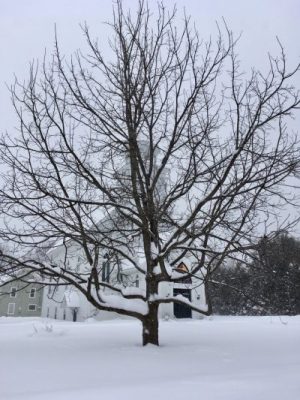Of Trees. And Newborns.

Un texte de Lynda Graham
Paru dans le numéro Printemps/Spring 2020
Publié le : 21 février 2020
Dernière mise à jour : 30 octobre 2020
Trees. Don’t you just love them? Individual trees can come to feel like an old friend—a friendly face that one sees daily. Opposite my house is a large oak. Even now in mid-winter it hangs on to some of its leaves. As if to remind me that new fresh green ones will appear in due…
Trees. Don’t you just love them? Individual trees can come to feel like an old friend—a friendly face that one sees daily. Opposite my house is a large oak. Even now in mid-winter it hangs on to some of its leaves. As if to remind me that new fresh green ones will appear in due course. Just down the road, in front of the former church that now houses Galerie Art Plus, is a black walnut tree. In autumn it produces quantities of fruits whose flesh contains compounds that dye the sidewalk as well as hands that try to break the notoriously hard to crack husk.
And of course, there is the magnificent maple just opposite the Sutton Town Hall. It is a barometer for the arrival of autumn. But who, if anyone, planted these trees? Did they self seed or was it a conscious act of someone planting a tree knowing that it would be primarily future generations who would enjoy it?
Planting trees
Sleep, creep, leap is an old gardening adage that reminds us that most plants may at first appear to be sleeping whilst in fact they are busy underground sending out roots to establish a strong foundation; next they begin to creep with tentative new growth but only finally do they leap into life once they are truly well established below ground. In the case of shrubs, this process is typically three years but for many tree species it can be much longer.
I planted some oak saplings just 18 inches tall about ten years ago. For at least five years they most definitely seemed to be asleep. With, at best, a tiny bit of tentative new growth. I had almost given up on them. Then, one year, I suddenly realized that they were now five feet tall and now double that! The point is that planting most of the slower growing hardwood trees must be considered as a gift for the future. And this gift is becoming more and more important in the fight against the climate crisis that confronts us.
Trees alone are not enough to solve the problem of global heating. There seems to be a lot of scientific evidence that tree planting is both a simple and an inexpensive way to combat global heating. Trees help clean the air and they slow down rainwater to reduce the threat of flooding. They can increase biodiversity if we are thoughtful about what we plant and, crucially, they store carbon. So, every tree counts. Let me repeat that: EVERY tree counts.
Newborns
Living as we do in Quebec, and especially here in Sutton in the crook of the mountains, it is easy to think as we look around that we have plenty of trees. But every tree that we add contributes to the global tree mass. Look for a space that could welcome a tree, or two, or three, and of different sorts. Plant it knowing that you may not be around to enjoy it. But know that you are doing your part to ensure future generations can.
A great time to do this is in May. It just happens to be the official Tree and Forest Month here in Quebec. To celebrate this month the provincial government’s Mon arbre à moi program provides every child born or adopted in Quebec with a seedling tree that they can grow up with. This year every child born or adopted between April 16, 2019, and April 15, 2020, has the right to receive a tree in May 2020. All it takes is a simple on-line form completed by April 15, 2020. For all the details, visit Mon arbre à moi. And if you don’t have a place to plant it just let me know and we will find one together.
